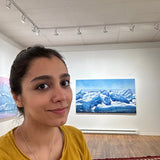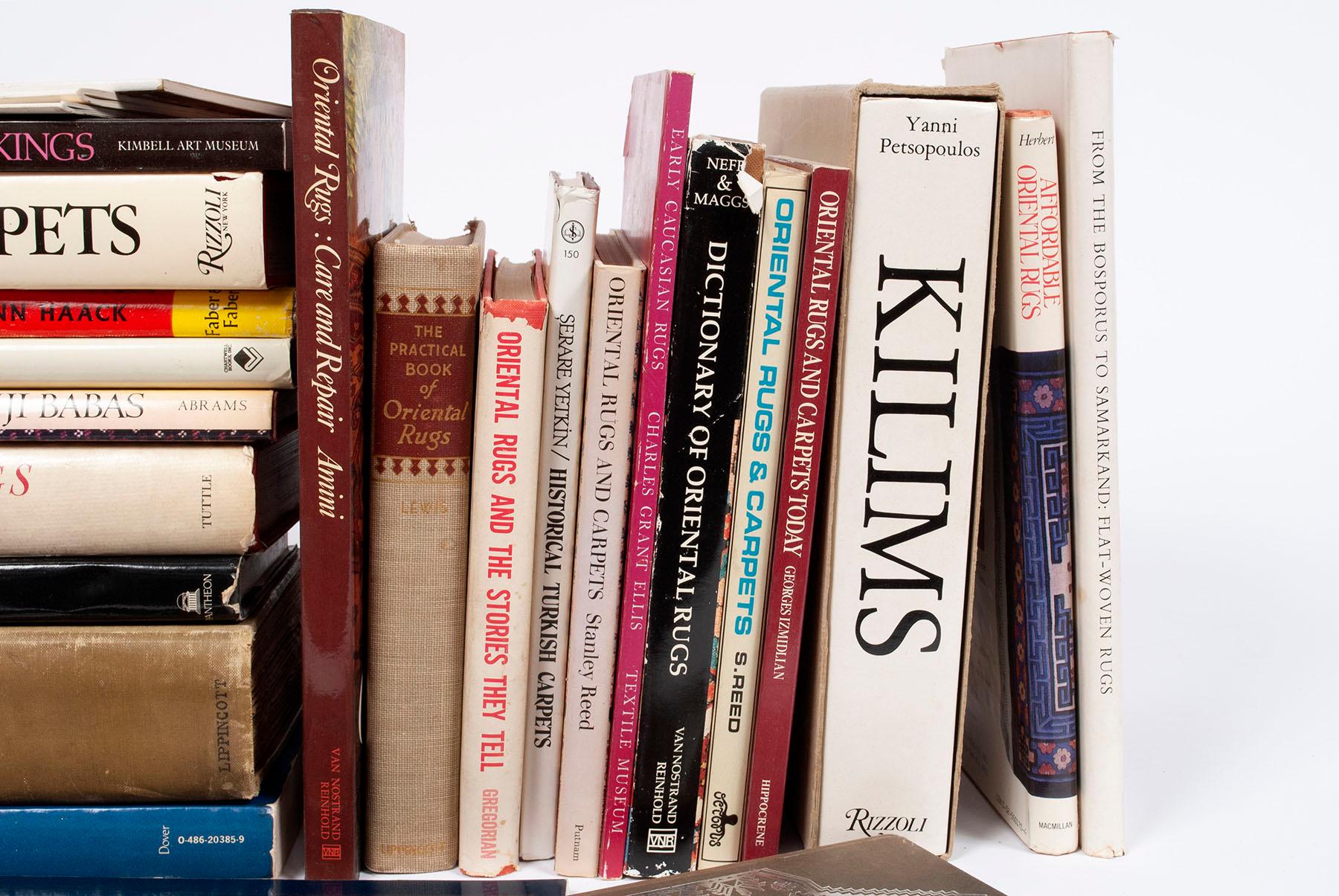Kashan carpets have long graced palace halls, museum galleries, and refined homes, standing as emblems of Persian artistry.
In central Iran, the city of Kashan became almost synonymous with high weaving, its people entwined with loom and dye vat for centuries. Across different eras, Kashan produced some of the most admired carpets ever made.
Below, we travel through that history, then open up the designs, colors, and construction that give Kashan rugs their unmistakable poise.

Ellie at the Tabatabaei House in Kashan (photo, of course, by Hanif).
From Sialk to Safavid: Deep Roots in an Art-Making City
Just outside Kashan lie the Sialk mounds, Tepe Sialk, an archaeological complex dating back some 7,000 years. While we cannot draw a straight line from prehistoric pottery to modern carpet cartoons, there is a real continuity of craftsmanship here.
This region became famous for textiles and ceramics long before carpets made Kashan world-renowned. Patterns we see on later Kashan wares, such as curving vines, flower heads, and balanced symmetry, feel like echoes of a very old visual language.

Pottery vessel from the 4th millennium BC, Tepe Sialk, Iran.
In the Safavid era, 16th to 17th centuries, Kashan was a thriving Silk Road city celebrated for fine silks and brocades. Under Shah Abbas I, who favored and invested in Kashan, carpet weaving flourished under court patronage.
Workshops in Kashan and in nearby Isfahan produced luminous silk pile carpets with gold and silver wrapped highlights that Europeans later called Polonaise carpets because many ended up in Polish royal collections. Their present pastel shimmer often owes to silver threads that have tarnished over time. Originally these carpets must have glittered like jewelry. They were ceremonial, diplomatic, and spectacular.

Polonaise carpet, Kashan (Iran), 17th century, The Metropolitan Museum of Art.
The Ardabil Connection and a Name that Matters
One of the most famous carpets in the world, the Ardabil Carpet at the V&A in London, bears an inscription naming Maqsud of Kashan. Scholars debate where the piece was woven, and Tabriz is often proposed, but the inscription signals a Kashan master overseeing the work. Even if looms were set up in Ardabil for the commission, the Kashani hand in design and quality control is part of its story.

Ardabil Carpet, 1539–40 AD, Victoria and Albert Museum, London.
Qajar Revival and the Mohtasham Legend
After cycles of prosperity and pause, Kashan surged again in the late 19th century during the Qajar period. A master weaver, Mohtasham Kashani, active roughly mid 1800s, became synonymous with excellence.
His workshops used exceptionally fine yarns, often imported merino from Manchester, to achieve a velvet like pile, fluid curves, and refined detail.
Collectors still speak reverently of Mohtasham Kashan, sometimes referring to the man’s own output, sometimes to the style that outlived him.
Think short velvety pile, poised medallions, ruby and indigo grounds that glow, and in some examples distinctive cochineal inflected purple or magenta notes.

Mohtasham Kashan rug from the Haj Molla Hasan Mohtashami workshop.
By the early 20th century, Kashan managed a full export renaissance. Silk and fine wool rugs traveled widely. The Second World War briefly dimmed production, which rebounded afterward.
Today, Kashan weavers still produce high quality hand knotted carpets, even as machine made goods share the market, and older Kashans remain coveted by collectors.

Kashan “Mohtasham” prayer rug, Central Persia, c. 1890.
A Design Language That Defines Persian
When many people imagine a classic Persian carpet, they are picturing Kashan.
Medallion and corners, Lachak Toranj.
The central medallion, frequently an oval or rounded star with slender pendants, sits like a sunburst at the heart of the field. In each of the four corners, a quarter medallion echoes it. Within and around these anchors, Shah Abbasi lotus palmettes, leafy sprays, and arabesques unfurl in balanced symmetry. Kashan favors generous floral heads connected by elegant, usually not overly dense, vinework. Compared to Isfahan’s intricate networks of eslimi vines, Kashan often reads slightly calmer, more flower forward and serenely ordered.

Classic Kashan rug with corner design, Rug the Rock collection.
Beyond the medallion.
While the medallion corner layout is the archetype, Kashan looms have also produced:
-
Afshan all over floral fields without a central medallion
-
Prayer, Mihrab, compositions with suspended lamps and richly decorated niches
-
Panel and Garden rugs in compartments
-
Pictorials and inscription pieces such as poetry cartouches or workshop signatures
-
Occasional hunting scenes and naturalistic Gol e Farangi, European rose, bouquets that became popular in the late 19th and early 20th century

Kashan prayer rug with mihrab design.
Borders that frame with majesty.
Traditional Kashan borders often feature stately repeats of large Shah Abbasi palmettes linked by scrolling vines, flanked by guard borders. Older examples sometimes show seven band border systems. Later pieces more often present three or five. In the trade you may hear a Mostofi border referenced with Kashan. The term appears in dealer parlance for specific historic layouts, but it is not a rigorously standardized label in scholarship. Treat it as a traditional Kashan border type rather than a strict taxonomy.

Color and Dye: The Kashan Glow
Kashan’s dyeing heritage is storied. Master dyers worked with indigo for deep navy through sky, madder for warm reds, and at times Armenian cochineal to achieve a blue leaning crimson that feels different from madder’s orange leaning reds.
This is one reason older Kashans can carry a saturated ruby or wine field that seems to emit light. Ivory and cream, often undyed or lightly toned wool, frame and freshen. Soft golden yellows and mid greens flesh out petals and leaves. Black or near black lines are used sparingly to outline and give snap to forms.
Through the 20th century, chrome and other synthetic dyes entered workshops for cost and consistency. High end makers sometimes stayed with, or have since returned to, natural palettes.
Either way, classic Kashan harmony remains. A deep red field with navy border, or a navy field with crimson or cream border, allows each part of the composition to steady and heighten the other.

Structure and Handle: Why They Feel the Way They Do
Knot and loom.
Kashan rugs are hand knotted on vertical looms using the asymmetrical, Persian, knot. Foundations are typically cotton warp and weft from the 19th century onward. Safavid silk masterpieces are the exception.
Density.
Good workshop Kashans commonly fall around 120 to 300 plus kpsi, knots per square inch. Mohtasham level pieces can exceed that. Exceptional silk or showpieces may go higher, but those are outliers. What matters to the eye is how the fineness translates into crisp curves, articulate petals, and that dignified calm focus across the field.
Yarn and pile.
High quality kork, lamb’s, wool gives Kashans a soft, slightly lustrous surface. Manchester merino in 19th century masterwork contributed to the famous velour like pile. Pile is clipped low to medium, bringing clarity to the drawing while retaining a sumptuous hand.
Edges and ends.
Selvages are neatly overcast over two to four warp cords. Ends are secured with short kilim or overcasting, then fringe. Many fine examples carry a woven workshop signature in the border or field, a detail connoisseurs love.

Why Kashan Endures
A Kashan rug is classic without feeling formulaic. The medallion sings but never shouts. Colors glow rather than glare. The balance of curve and symmetry calms a room, and the minute drawing rewards a closer look. For collectors, older Kashans, especially documented Mohtasham pieces, early 20th century fine workshop rugs, and well preserved silk examples, are prized. For design, Kashans carry easily from formal rooms to contemporary spaces that want an anchor of heritage.
Beyond aesthetics, Kashan weaving is human. For generations, families have knotted to poetry and song, passing down rhythms of hand and eye. When you roll out a Kashan, you place that lineage underfoot, art you can live with every day.

Kashan rug with Afshan design, Rug the Rock collection.
Buying Notes
-
Look for balanced drawing, strong but harmonious color, and a handle that feels supple yet substantial.
-
Expect wool pile on cotton foundation for most 19th and 20th century pieces. Silk pile appears on rarities.
-
Signatures and fine, even clipping are good signs in workshop rugs.
-
Condition matters. Check ends and selvages, pile wear, and possible re dyes.
-
Attribution requires care. Beware machine made or non Iranian imitations. True Kashan shows a recognizable drawing hand, curve fidelity, and material quality.

Conclusion: A Persian Icon
Kashan rugs sit at the intersection of history, technique, and taste. From Safavid silk splendors to Qajar and early Pahlavi workshop masterpieces, they chart centuries of refinement. If you are drawn to their quiet radiance, the dignified medallion, the fluent florals, that unmistakable Kashan red and blue, you are in good company. Curators, connoisseurs, and homeowners have loved them for generations.
Explore carefully, choose with your eyes and hands, and a Kashan will reward you for a lifetime.
















Leave a comment